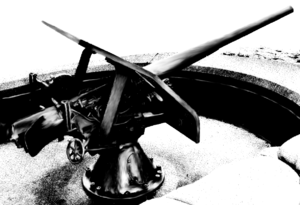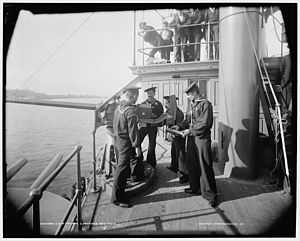Driggs-Seabury
Driggs-Seabury Ordnance Company was founded by William H. Driggs and Samuel Seabury, both US Navy officers, circa 1898, originally to produce guns for the US Army and US Navy designed by the partners. Although Seabury died in 1902, followed by Driggs in 1908, the company continued under the leadership of Louis Labodie “L. L.” Driggs until 1925. The company manufactured motor vehicles 1913-15 and 1921-25, but sold its weapons production and plant in Sharon, Pennsylvania to Savage Arms in a 1915 merger.[1][2][3] Under Savage Arms, the Sharon plant made Lewis guns in World War I. Dropping the Seabury name, Driggs was reconstituted as a motor vehicle manufacturer in New Haven, Connecticut in 1921, confusingly named “Driggs Ordnance & Manufacturing Corporation”. Driggs folded for good in 1925.
Weapons
Driggs-Seabury was preceded by Driggs-Schroeder, a series of weapons designed by W. H. Driggs and Seaton Schroeder in the late 1880s and produced by the American Ordnance Company in the 1890s. Weapons produced by Driggs-Seabury included:

- 3-inch gun M1898 (aka 15-pounder),[4] a coast defense weapon for the Army on a retractable "masking parapet" carriage, also made by Driggs-Seabury. 120 guns and carriages were built. It was later used as the basis for the 3-inch Gun M1918, an anti-aircraft weapon.
- US Navy 3"/23 caliber gun Mark 13 during World War I. This had a semi-automatic horizontal sliding breech block. In this case semi-automatic means the breech opens and the cartridge is ejected on firing, ready for the next round to be loaded manually.[5]

- The Navy 6-pounder Mark 11 and 3-pounder Mark 14 were made by Driggs-Seabury.[6]
- Two 6-pounder Driggs-Seabury guns were adopted by the US Army and designated the M1898 and M1900.[7] References to Marks II and III Driggs-Seabury weapons appear to describe earlier Driggs-Schroeder weapons manufactured by American Ordnance, possibly similar to the Navy Marks 6 and 8.[8][9]
- a 3.2-inch field gun, possibly the M1897.[10][11][12]
- The breech mechanism for the US Navy 3"/50 caliber gun Mark 5.[13]
Vehicles
The vehicles produced by Driggs-Seabury included:

- 1913 Twombly cyclecar, a small two-seat automobile. Cyclecars were small, inexpensive vehicles that were popular 1910-29.[14]
- 1915 Vulcan Power Wagon truck, rated at three to seven tons depending on model.[15][16]
- 1921 Driggs Model D, a coupe.[17]
- 1923 Driggs taxicab, built for the Diamond Taxicab Company of New York City. Another successful bidder was Elcar, and an unsuccessful one was Ace.[18]
References
- ↑ Poor’s Manual of Industrials, 1916, Vol. 7, New York: Redmond & Co., pp. 1722-1726
- ↑ Unofficial Savage Arms company history
- ↑ Official Savage Arms company history
- ↑ Lohrer, George L. Ordnance Supply Manual, U. S. Ordnance Dept., Washington: Government Printing Office, 1904, pp. 295-300
- ↑ DiGiulian, Tony 3"/23 gun at Navweaps.com
- ↑ Campbell, p. 147
- ↑ Lohrer, George L. Ordnance Supply Manual, U. S. Ordnance Dept., Washington: Government Printing Office, 1904, pp. 282-295
- ↑ DiGiulian, Tony US 6-pounder guns Mks 1-13
- ↑ Campbell, p. 147
- ↑ Blueprint for a Driggs-Schroeder 3.2-inch gun from Winchester Repeating Arms Company, at the Buffalo Bill Center of the West
- ↑ Ordnance Dept, U. S. Army (1917). Handbook of the 3.2-inch Field Battery. Washington: Government Printing Office.
- ↑ Scientific American Vol. 79, Issue 6, article on the 3.2-inch Driggs-Seabury field gun
- ↑ DiGiulian, Tony, 3-inch gun Marks 2, 3, 5, 6, and 8 at Navweaps.com
- ↑ Twombly cyclecar description
- ↑ Hemmings Motor News, December 2011
- ↑ Vulcan Power Wagon article, 1912
- ↑ History of Early American Automobile Industry, 1921, Ch. 29, Section “Driggs” (from Motor Age magazine)
- ↑ Diamond Cab built by Driggs Company, Automotive Industries magazine, 5 October 1922
- Campbell, John (1985). Naval Weapons of World War Two. Annapolis: Naval Institute Press. ISBN 0-87021-459-4.